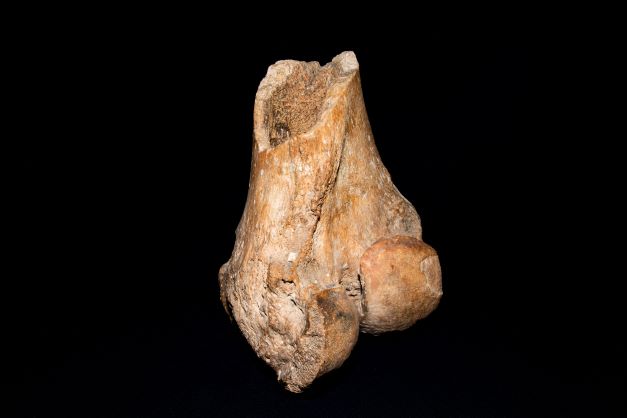UTRGV Coastal Studies Lab (SPI)
PLEISTOCENE MEGAFAUNA REMAINS AT THE UTRGV COASTAL STUDIES LAB
MAMMOTH FEMUR

Mammoth remains, mostly molars, fragments of large bones, and parts of tusks have been found in near surface deposits in Starr County and south of the Rio Grande. In 1975, in twenty meters of water 16 kilometers (10 miles) off South Padre Island the nets of a shrimp boat snagged a portion of a mammoth femur. This find demonstrates that mammoths and possibly other Pleistocene megafauna lived on the now submerged continental shelf. While these finds lack context and are hard to place chronologically, it is likely that mammoths were in the area from 200,000 to 10,000 years ago. It is believed they became extinct during the Holocene amid a warming climate and widespread human hunting.
A full-size replica of a woolly Mammoth skeleton can be viewed at the Museum of South Texas History in Edinburg. A 1.5 meter (5 foot) tusk weighing 50 pounds [22.7 kg] and several mammoth molars were recovered from a gravel pit in La Joya in the 1970s. They are now part of the paleontological collection at the Geology Department at UTRGV.
Among the ancient animals that roamed the RGV were Mammoth and Bison, and a large land tortoise that lived along the banks of the Rio Grande.
The Wooly Mammoth, Mammuthus primigenius lived in the area for much of the last 200,000 years. Mammoth molars, fragments of large bones, and parts of tusks have been found in surface deposits in Starr County and south of the Rio Grande. A portion of a mammoth femur was snagged by the nets of a shrimp boat in 40 feet of water, and 30 miles offshore of South Padre Island, indicating that mammoths and likely other animals lived on the continental shelf during glacial periods when sea level was more than 300 feet lower.
The mammoth femur is currently on display at the UTRGV Coastal Studies Lab on South Padre Island.
A 1.5-meter (5 foot) tusk weighing 50 pounds [22.7 kg] and several mammoth molars were recovered from a gravel pit in La Joya in the 1960s. They are now part of the paleontological collection at the Geology Department at UTRGV.
A full-size replica of a woolly Mammoth skeleton can be viewed at the Museum of South Texas History in Edinburg.
Listen in English - Pleistocene Megafauna and the UTRGV Coastal Studies Lab
Entre los animales prehistóricos que campaban por El Valle del Río Grande se encontraban el mamut y el bisonte, así como una enorme tortuga terrestre que habitaba en las márgenes del Río Grande.
El lanudo mamut, o Mammuthus primigenius, pobló la región durante una buena parte de los últimos 200 000 años. En los depósitos superficiales del condado de Starr y en el lado sur del Río Grande se han hallado molares de mamut, así como fragmentos de huesos de gran tamaño y secciones de los colmillos. Un fragmento de fémur de mamut quedó atrapado en las redes de un barco camaronero a una profundidad de más de diez metros bajo el agua y a unos 50 kilómetros mar adentro desde la Isla del Padre. Esto indica que tanto los mamuts como posiblemente otros animales habitaron en la plataforma continental durante los periodos de glaciación en los que el nivel del mar era unos 100 metros inferior. El fémur se encuentra en la actualidad expuesto en el Laboratorio de Ciencias del Litoral Marino de UTRGV, ubicado en la Isla del Padre.
En la década de 1960 se encontraron varios molares en una cantera de grava en La Joya, así como un colmillo de casi de 23 kilos de peso y metro y medio de longitud, todos ellos parte de la colección paleontológica del Departamento de Geología de UTRGV. Finalmente, una reproducción a tamaño real del esqueleto de un mamut lanudo puede verse en el Museo de Historia del Sur de Texas, en Edinburg.
Escucha en Español – la colección paleontológica del Departamento de Geología de UTRGV
UTRGV COASTAL STUDIES LAB - SOUTH PADRE ISLAND
The Coastal Studies Laboratory located on South Padre Island was established in 1973, and is dedicated to providing educational opportunities, enhancing research, engaging in public service, and providing community outreach related to coastal and marine concerns in the Gulf of Mexico with special emphasis on the South Texas region.
